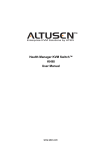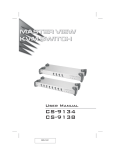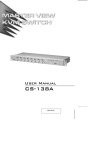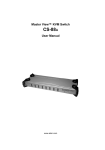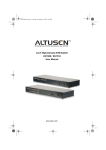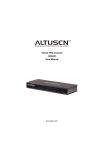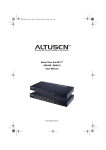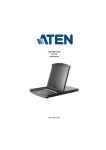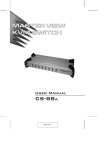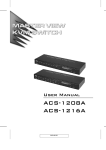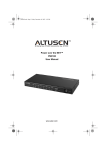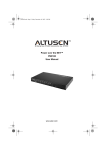Download ATEN Technology ATEN KH98 User's Manual
Transcript
KH98.book Page i Thursday, April 26, 2007 5:48 PM Health Manager KVM Switch™ KH98 User Manual www.aten.com KH98.book Page ii Thursday, April 26, 2007 5:48 PM KH98 User Manual FCC Information This is an FCC Class A product. In a domestic environment this product may cause radio interference in which case the user may be required to take adequate measures. This equipment has been tested and found to comply with the limits for a Class A digital device, pursuant to Part 15 of the FCC Rules. These limits are designed to provide reasonable protection against harmful interference when the equipment is operated in a commercial environment. This equipment generates, uses and can radiate radio frequency energy and, if not installed and used in accordance with the instruction manual, may cause harmful interference to radio communications. Operation of this equipment in a residential area is likely to cause harmful interference in which case the user will be required to correct the interference at his own expense. RoHS This product is RoHS compliant. SJ/T 11364-2006 The following contains information that relates to China. ii KH98.book Page iii Thursday, April 26, 2007 5:48 PM KH98 User Manual User Information Online Registration Be sure to register your product at our online support center: International – http://support.aten.com North America – http://www.aten-usa.com/product_registration Technical Support Telephone: International: 886-2-8692-6959 North America: 1-888-999-ATEN Online: Online technical support is available to ATEN customers through our support center. See Technical Support, page xiii, for details. User Notice All information, documentation, and specifications contained in this manual are subject to change without prior notification by the manufacturer. The manufacturer makes no representations or warranties, either expressed or implied, with respect to the contents hereof and specifically disclaims any warranties as to merchantability or fitness for any particular purpose. Any of the manufacturer's software described in this manual is sold or licensed `as is'. Should the programs prove defective following their purchase, the buyer (and not the manufacturer, its distributor, or its dealer), assumes the entire cost of all necessary servicing, repair and any incidental or consequential damages resulting from any defect in the software. The manufacturer of this system is not responsible for any radio and/or TV interference caused by unauthorized modifications to this device. It is the responsibility of the user to correct such interference. The manufacturer is not responsible for any damage incurred in the operation of this system if the correct operational voltage setting was not selected prior to operation. PLEASE VERIFY THAT THE VOLTAGE SETTING IS CORRECT BEFORE USE. iii KH98.book Page iv Thursday, April 26, 2007 5:48 PM KH98 User Manual Safety Instructions General Read all of these instructions. Save them for future reference. Follow all warnings and instructions marked on the device. Do not place the device on any unstable surface (cart, stand, table, etc.). If the device falls, serious damage will result. Do not use the device near water. Do not place the device near, or over, radiators or heat registers. The device cabinet is provided with slots and openings to allow for adequate ventilation. To ensure reliable operation, and to protect against overheating, these openings must never be blocked or covered. The device should never be placed on a soft surface (bed, sofa, rug, etc.) as this will block its ventilation openings. Likewise, the device should not be placed in a built in enclosure unless adequate ventilation has been provided. Never spill liquid of any kind on the device. Unplug the device from the wall outlet before cleaning. Do not use liquid or aerosol cleaners. Use a damp cloth for cleaning. The device should be operated from the type of power source indicated on the marking label. If you are not sure of the type of power available, consult your dealer or local power company. The device is equipped with a 3-wire grounding type plug. This is a safety feature. If you are unable to insert the plug into the outlet, contact your electrician to replace your obsolete outlet. Do not attempt to defeat the purpose of the grounding-type plug. Always follow your local/national wiring codes. Do not allow anything to rest on the power cord or cables. Route the power cord and cables so that they cannot be stepped on or tripped over. If an extension cord is used with this device make sure that the total of the ampere ratings of all products used on this cord does not exceed the extension cord ampere rating. Make sure that the total of all products plugged into the wall outlet does not exceed 15 amperes. To help protect your system from sudden, transient increases and decreases in electrical power, use a surge suppressor, line conditioner, or uninterruptible power supply (UPS). iv KH98.book Page v Thursday, April 26, 2007 5:48 PM KH98 User Manual Position system cables and power cables carefully; Be sure that nothing rests on any cables. When connecting or disconnecting power to hot pluggable power supplies, observe the following guidelines: Install the power supply before connecting the power cable to the power supply. Unplug the power cable before removing the power supply. If the system has multiple sources of power, disconnect power from the system by unplugging all power cables from the power supplies. Never push objects of any kind into or through cabinet slots. They may touch dangerous voltage points or short out parts resulting in a risk of fire or electrical shock. Do not attempt to service the device yourself. Refer all servicing to qualified service personnel. If the following conditions occur, unplug the device from the wall outlet and bring it to qualified service personnel for repair. The power cord or plug has become damaged or frayed. Liquid has been spilled into the device. The device has been exposed to rain or water. The device has been dropped, or the cabinet has been damaged. The device exhibits a distinct change in performance, indicating a need for service. The device does not operate normally when the operating instructions are followed. Only adjust those controls that are covered in the operating instructions. Improper adjustment of other controls may result in damage that will require extensive work by a qualified technician to repair. v KH98.book Page vi Thursday, April 26, 2007 5:48 PM KH98 User Manual Rack Mounting Before working on the rack, make sure that the stabilizers are secured to the rack, extended to the floor, and that the full weight of the rack rests on the floor. Install front and side stabilizers on a single rack or front stabilizers for joined multiple racks before working on the rack. Always load the rack from the bottom up, and load the heaviest item in the rack first. Make sure that the rack is level and stable before extending a device from the rack. Use caution when pressing the device rail release latches and sliding a device into or out of a rack; the slide rails can pinch your fingers. After a device is inserted into the rack, carefully extend the rail into a locking position, and then slide the device into the rack. Do not overload the AC supply branch circuit that provides power to the rack. The total rack load should not exceed 80 percent of the branch circuit rating. Ensure that proper airflow is provided to devices in the rack. Do not step on or stand on any device when servicing other devices in a rack. vi KH98.book Page vii Thursday, April 26, 2007 5:48 PM KH98 User Manual Package Contents The KH98 package consists of: 1 KH98 KVM Switch 1 Firmware Upgrade Cable 1 Power Cord 1 Rack Mount Kit (Brackets and Phillips head hex M3 x 8 screws) 1 Foot Pad Set (4 pcs.) 1 User Manual* 1 Quick Start Guide 1 Registration Card Check to make sure that all of the components are present and in good order. If anything is missing, or was damaged in shipping, contact your dealer. Read this manual thoroughly and follow the installation and operation procedures carefully to prevent any damage to the switch or to any other devices on the KH98 installation. * Changes may have been made to the manual since it was printed. Please visit our website to check for the most up-to-date version. Copyright © 2006 ATEN® International Co., Ltd. Manual Part No. PAPE-0236-2AXG Printing Date:04/2007 Altusen and the Altusen logo are registered trademarks of ATEN International Co., Ltd. All rights reserved. All other brand names and trademarks are the registered property of their respective owners. vii KH98.book Page viii Thursday, April 26, 2007 5:48 PM KH98 User Manual Contents FCC Information . . . . . . . . . . . . . . . . . . . . . . . . . . . . . . . . . . . . . . . . . . . . . ii SJ/T 11364-2006 . . . . . . . . . . . . . . . . . . . . . . . . . . . . . . . . . . . . . . . . . . . . ii User Information . . . . . . . . . . . . . . . . . . . . . . . . . . . . . . . . . . . . . . . . . . . . . iii Online Registration . . . . . . . . . . . . . . . . . . . . . . . . . . . . . . . . . . . . . . . . iii Technical Support . . . . . . . . . . . . . . . . . . . . . . . . . . . . . . . . . . . . . . . . . iii User Notice . . . . . . . . . . . . . . . . . . . . . . . . . . . . . . . . . . . . . . . . . . . . . . . . . iii Safety Instructions . . . . . . . . . . . . . . . . . . . . . . . . . . . . . . . . . . . . . . . . . . .iv General . . . . . . . . . . . . . . . . . . . . . . . . . . . . . . . . . . . . . . . . . . . . . . . . .iv Rack Mounting . . . . . . . . . . . . . . . . . . . . . . . . . . . . . . . . . . . . . . . . . . .vi Package Contents . . . . . . . . . . . . . . . . . . . . . . . . . . . . . . . . . . . . . . . . . . vii About This Manual . . . . . . . . . . . . . . . . . . . . . . . . . . . . . . . . . . . . . . . . . . .xi Overview . . . . . . . . . . . . . . . . . . . . . . . . . . . . . . . . . . . . . . . . . . . . . . . .xi Conventions . . . . . . . . . . . . . . . . . . . . . . . . . . . . . . . . . . . . . . . . . . . . xii Technical Support. . . . . . . . . . . . . . . . . . . . . . . . . . . . . . . . . . . . . . . . . . . xiii International . . . . . . . . . . . . . . . . . . . . . . . . . . . . . . . . . . . . . . . . . . . . xiii North America . . . . . . . . . . . . . . . . . . . . . . . . . . . . . . . . . . . . . . . . . . . xiii Product Information . . . . . . . . . . . . . . . . . . . . . . . . . . . . . . . . . . . . . . . . . xiv Chapter 1. Introduction Overview. . . . . . . . . . . . . . . . . . . . . . . . . . . . . . . . . . . . . . . . . . . . . . . . . . . 1 Features . . . . . . . . . . . . . . . . . . . . . . . . . . . . . . . . . . . . . . . . . . . . . . . . . . . 2 System Requirements . . . . . . . . . . . . . . . . . . . . . . . . . . . . . . . . . . . . . . . . 3 Console . . . . . . . . . . . . . . . . . . . . . . . . . . . . . . . . . . . . . . . . . . . . . . . . . 3 Computer . . . . . . . . . . . . . . . . . . . . . . . . . . . . . . . . . . . . . . . . . . . . . . . 3 Cables . . . . . . . . . . . . . . . . . . . . . . . . . . . . . . . . . . . . . . . . . . . . . . . . . . 3 Operating Systems . . . . . . . . . . . . . . . . . . . . . . . . . . . . . . . . . . . . . . . . 4 Components . . . . . . . . . . . . . . . . . . . . . . . . . . . . . . . . . . . . . . . . . . . . . . . . 5 Front View . . . . . . . . . . . . . . . . . . . . . . . . . . . . . . . . . . . . . . . . . . . . . . . 5 Rear View . . . . . . . . . . . . . . . . . . . . . . . . . . . . . . . . . . . . . . . . . . . . . . . 7 Chapter 2. Hardware Setup Installation. . . . . . . . . . . . . . . . . . . . . . . . . . . . . . . . . . . . . . . . . . . . . . . . . . 9 Single Stage Installation . . . . . . . . . . . . . . . . . . . . . . . . . . . . . . . . . . . . 9 Two Stage Installation. . . . . . . . . . . . . . . . . . . . . . . . . . . . . . . . . . . . . 10 Three Stage Installation . . . . . . . . . . . . . . . . . . . . . . . . . . . . . . . . . . . 12 Setup Considerations . . . . . . . . . . . . . . . . . . . . . . . . . . . . . . . . . . . . . . . . 14 Hot Plugging . . . . . . . . . . . . . . . . . . . . . . . . . . . . . . . . . . . . . . . . . . . . 14 Hot Plugging KVM Ports:. . . . . . . . . . . . . . . . . . . . . . . . . . . . . . . . 14 Hot Plugging Console Ports: . . . . . . . . . . . . . . . . . . . . . . . . . . . . . 14 Powering Off and Restarting . . . . . . . . . . . . . . . . . . . . . . . . . . . . . . . . 15 Port ID Numbering . . . . . . . . . . . . . . . . . . . . . . . . . . . . . . . . . . . . . . . 16 Port Selection . . . . . . . . . . . . . . . . . . . . . . . . . . . . . . . . . . . . . . . . . . . 17 viii KH98.book Page ix Thursday, April 26, 2007 5:48 PM KH98 User Manual Manual: . . . . . . . . . . . . . . . . . . . . . . . . . . . . . . . . . . . . . . . . . . . . . 17 OSD: . . . . . . . . . . . . . . . . . . . . . . . . . . . . . . . . . . . . . . . . . . . . . . . 17 Hotkey:. . . . . . . . . . . . . . . . . . . . . . . . . . . . . . . . . . . . . . . . . . . . . . 17 Chapter 3. OSD Operation OSD Overview . . . . . . . . . . . . . . . . . . . . . . . . . . . . . . . . . . . . . . . . . . . . . 19 OSD Main Screen Headings . . . . . . . . . . . . . . . . . . . . . . . . . . . . . . . . . . . 21 OSD Navigation . . . . . . . . . . . . . . . . . . . . . . . . . . . . . . . . . . . . . . . . . . . . 21 OSD Functions . . . . . . . . . . . . . . . . . . . . . . . . . . . . . . . . . . . . . . . . . . . . . 22 F1 GOTO: . . . . . . . . . . . . . . . . . . . . . . . . . . . . . . . . . . . . . . . . . . . . . . 22 F2 LIST:. . . . . . . . . . . . . . . . . . . . . . . . . . . . . . . . . . . . . . . . . . . . . . . . 23 F3 SET: . . . . . . . . . . . . . . . . . . . . . . . . . . . . . . . . . . . . . . . . . . . . . . . . 24 F4 ADM: . . . . . . . . . . . . . . . . . . . . . . . . . . . . . . . . . . . . . . . . . . . . . . . 26 F5 BMC: . . . . . . . . . . . . . . . . . . . . . . . . . . . . . . . . . . . . . . . . . . . . . . . 31 F6 PET: . . . . . . . . . . . . . . . . . . . . . . . . . . . . . . . . . . . . . . . . . . . . . . . . 33 The KVM PET AUTO SWITCH . . . . . . . . . . . . . . . . . . . . . . . . . . . 33 F7 SCAN: . . . . . . . . . . . . . . . . . . . . . . . . . . . . . . . . . . . . . . . . . . . . . . 34 F8 LOUT:. . . . . . . . . . . . . . . . . . . . . . . . . . . . . . . . . . . . . . . . . . . . . . . 35 Chapter 4. Hotkey Operation Hotkey Port Control. . . . . . . . . . . . . . . . . . . . . . . . . . . . . . . . . . . . . . . . . . 37 Invoking Hotkey Mode . . . . . . . . . . . . . . . . . . . . . . . . . . . . . . . . . . . . . 37 Selecting the Active Port . . . . . . . . . . . . . . . . . . . . . . . . . . . . . . . . . . . 38 Port Key In Examples: . . . . . . . . . . . . . . . . . . . . . . . . . . . . . . . . . . 38 Auto Scanning . . . . . . . . . . . . . . . . . . . . . . . . . . . . . . . . . . . . . . . . . . . 39 Setting the Scan Interval . . . . . . . . . . . . . . . . . . . . . . . . . . . . . . . . . . . 39 Invoking Auto Scan . . . . . . . . . . . . . . . . . . . . . . . . . . . . . . . . . . . . . . . 40 Hotkey Beeper Control . . . . . . . . . . . . . . . . . . . . . . . . . . . . . . . . . . . . . . . 41 Hotkey Summary Table. . . . . . . . . . . . . . . . . . . . . . . . . . . . . . . . . . . . . . . 41 Chapter 5. The Firmware Upgrade Utility Introduction . . . . . . . . . . . . . . . . . . . . . . . . . . . . . . . . . . . . . . . . . . . . . . . . 43 Before You Begin . . . . . . . . . . . . . . . . . . . . . . . . . . . . . . . . . . . . . . . . . . . 44 Performing the Upgrade . . . . . . . . . . . . . . . . . . . . . . . . . . . . . . . . . . . . . . 45 Starting the Upgrade . . . . . . . . . . . . . . . . . . . . . . . . . . . . . . . . . . . . . . 45 Upgrade Succeeded . . . . . . . . . . . . . . . . . . . . . . . . . . . . . . . . . . . . . . 48 Upgrade Failed . . . . . . . . . . . . . . . . . . . . . . . . . . . . . . . . . . . . . . . . . . 49 Firmware Upgrade Recovery . . . . . . . . . . . . . . . . . . . . . . . . . . . . . . . . . . 50 Appendix KH98 Computer Support Table. . . . . . . . . . . . . . . . . . . . . . . . . . . . . . . . . 51 OSD Factory Default Settings . . . . . . . . . . . . . . . . . . . . . . . . . . . . . . . . . . 52 Specifications . . . . . . . . . . . . . . . . . . . . . . . . . . . . . . . . . . . . . . . . . . . . . . 53 Clear Login Information. . . . . . . . . . . . . . . . . . . . . . . . . . . . . . . . . . . . . . . 54 ix KH98.book Page x Thursday, April 26, 2007 5:48 PM KH98 User Manual Troubleshooting . . . . . . . . . . . . . . . . . . . . . . . . . . . . . . . . . . . . . . . . . . . . 55 Stacking and Rack Mounting . . . . . . . . . . . . . . . . . . . . . . . . . . . . . . . . . . 56 Stacking . . . . . . . . . . . . . . . . . . . . . . . . . . . . . . . . . . . . . . . . . . . . . . . 56 Rack Mounting—Front . . . . . . . . . . . . . . . . . . . . . . . . . . . . . . . . . . . . 57 Rack Mounting—Rear. . . . . . . . . . . . . . . . . . . . . . . . . . . . . . . . . . . . . 59 Limited Warranty. . . . . . . . . . . . . . . . . . . . . . . . . . . . . . . . . . . . . . . . . . . . 61 Index x KH98.book Page xi Thursday, April 26, 2007 5:48 PM KH98 User Manual About This Manual This User Manual is provided to help you get the most from your KH98 system. It covers all aspects of installation, configuration and operation. An overview of the information found in the manual is provided below. Overview Chapter 1, Introduction, introduces you to the KH98 System. Its purpose, features and benefits are presented, and its front and back panel components are described. Chapter 2, Hardware Setup, provides step-by-step instructions for setting up your installation, and explains some basic operation procedures. Chapter 3, OSD Operation, explains how to use the OSD to access and control the computers connected to the switch. Chapter 4, Hotkey Operation, explains how to access and control the computers connected to the switch using Hotkeys. Chapter 5, The Firmware Upgrade Utility, explains how to upgrade the KH98’s Firmware. An Appendix, at the end of the manual provides technical and troubleshooting information. xi KH98.book Page xii Thursday, April 26, 2007 5:48 PM KH98 User Manual Conventions This manual uses the following conventions: Monospaced Indicates text that you should key in. [] Indicates keys you should press. For example, [Enter] means to press the Enter key. If keys need to be chorded, they appear together in the same bracket with a plus sign between them: [Ctrl+Alt]. 1. Numbered lists represent procedures with sequential steps. ♦ Bullet lists provide information, but do not involve sequential steps. → Indicates selecting the option (on a menu or dialog box, for example), that comes next. For example, Start → Run means to open the Start menu, and then select Run. Indicates critical information. xii KH98.book Page xiii Thursday, April 26, 2007 5:48 PM KH98 User Manual Technical Support International Email Support Email your questions and concerns to: [email protected] Online Support 1. Online technical support is available to ALTUSEN customers through our e-Support Center: http://support.aten.com Technical Support Troubleshooting Documentation Software Updates 2. Online troubleshooting that describes the most commonly encountered problems and offers possible solutions to them; online documentation (including electronically available manuals); and the latest drivers and firmware for your product are available at our website: http://www.aten.com North America Email Support Email your questions and concerns to: [email protected] Online Support 1. Online technical support is available to ALTUSEN customers through our e-Support Center: http://www.aten-usa.com/support Technical Support Troubleshooting Documentation Software Updates 2. Online troubleshooting that describes the most commonly encountered problems and offers possible solutions to them; online documentation (including electronically available manuals); and the latest drivers and firmware for your product are available at our website: http://www.aten-usa.com When you contact us, please have the following information ready beforehand: Product model number, serial number, and date of purchase. Your computer configuration, including operating system, revision level, expansion cards, and software. Any error messages displayed at the time the error occurred. The sequence of operations that led up to the error. Any other information you feel may be of help xiii KH98.book Page xiv Thursday, April 26, 2007 5:48 PM KH98 User Manual Product Information For information about all ALTUSEN products and how they can help you connect without limits, visit ALTUSEN on the Web or contact an ALTUSEN Authorized Reseller. Visit ALTUSEN on the Web for a list of locations and telephone numbers International – http://www.aten.com North America – http://www.aten-usa.com xiv KH98.book Page 1 Thursday, April 26, 2007 5:48 PM Chapter 1 Introduction Overview The KH98 KVM Switch offers multiple computer access and IPMI based monitoring from a single console (keyboard, monitor, and mouse). IPMI (Intelligent Platform Management Interface) is quickly becoming the industry standard for remote network infrastructure troubleshooting and failure prevention. IPMI provides server hardware health monitoring including CPU temperature, voltage, fan speed, etc., along with other remote maintenance features like system reset and power on/off. Best of all, IPMI can still be deployed remotely even if the system is down (Out of Band). For more information on enabling IPMI functionality, see F5 BMC:, page 31. The KH98 allows users to manage and maintain company infrastructure in a cost effective manner. A single KH98 can manage up to 8 computers. Since units can be cascaded to three levels, in a full three stage installation up to 73 KH98 units can control and monitor up to 512 computers - all from a single console. See Installation, page 9 for additional information. Setup is fast and easy; plugging cables into their appropriate ports is all that is entailed. There is no software to configure, so there is no need to get involved in complex installation routines or be concerned with incompatibility problems. Since the KH98 intercepts keyboard input directly, it works on any hardware platform and with all operating systems. There are three convenient methods to access any computer connected to the installation: (1) using the pushbuttons located on each unit's front panel; (2) entering Hotkey combinations from the keyboard; and (3) selecting from menus provided by the On Screen Display (OSD). A powerful Auto Scan feature also permits automatic scanning and monitoring of the activities of all computers running on the installation one by one. A KH98 installation: (1) eliminates the expense of having to purchase a separate keyboard, monitor, and mouse for each computer; (2) saves all the space those extra components would take up; (3) saves on energy costs; (4) eliminates constantly moving from one computer to another; and (5) cuts down Cost of Ownership by preventing system failure and reducing downtime. 1 KH98.book Page 2 Thursday, April 26, 2007 5:48 PM KH98 User Manual Features Server health monitoring - receive PET alerts and monitor up to 512 IPMI enabled servers from a single console (IPMI over LAN) Remote maintenance - system reset and power on/off for IPMI enabled servers Centralized management - control up to 512 computers (cascading) from a single console Robust security - Administrator/User password authorization for enhanced security protection Intelligent OSD (On Screen Display) and hotkey switching for efficient system handling Software free operation - computer selection via front panel switches, hotkeys, or On Screen Display (OSD) Auto scan - hands-free monitoring of user-selected computers Hot pluggable - add or remove computers without powering off the switch PS/2 mouse emulation for system bootup Console's PS/2 mouse controls all connected computers PS/2 compatible mouse support - Microsoft Intellimouse Explorer and Logitech FirstMouse+ Superior video quality: up to 1920 x 1440 @ 60Hz; DDC; DDC2; DDC2B Rack mountable in 19" (1U) system rack Patented ASIC Design for Enhanced Functionality and Compatibility KVM PET auto switch function - Upon receiving a PET alert, the KH98 will switch to the alert sending server and then display the alert information LED display for easy status monitoring Easy installation- be up and running in a few minutes (depending on installation environment) Note: 1. PS/2 compatible mouse support is for three button (wheel) mice. 2. The Logitech MouseWare program's Change Device procedure does not work on Microsoft NT systems. 2 KH98.book Page 3 Thursday, April 26, 2007 5:48 PM Chapter 1. Introduction System Requirements Console A VGA, SVGA, or Multisync monitor capable of the highest resolution you will be using on any computer in the installation. A PS/2 style mouse A PS/2 style keyboard Computer The following equipment must be installed on each computer: A VGA, SVGA or Multisync card. A 6-pin mini-DIN (PS/2 style) mouse port. A 6-pin mini-DIN (PS/2 Style) keyboard port with +5V DC on pin 4 and Ground on pin 3, or a keyboard port with +5V DC on pin 5 and ground on pin 4. (See the note under Cables in the next section). A Cat 5 cable for IPMI health monitoring (only for IPMI enabled servers) Cables Use of substandard cables may damage the connected devices or degrade overall performance. For optimum signal integrity and to simplify the layout, we strongly recommend that you use the following high quality Custom Cable sets: Cable Purpose Connect to Computer Part Number 2L-1001P/C (1.8m) or 2L-1003P/C (3m) Cascading 3 KH98.book Page 4 Thursday, April 26, 2007 5:48 PM KH98 User Manual Operating Systems The KH98 supports the following operating systems: Microsoft DOS 6.2 and higher Microsoft Windows NT 4 and higher Red Hat Linux 6.0 and higher Mandriva 9.0 and higher SUSE Linux 8.2 and higher Fedora Core 1 and higher Novell NetWare 5.0 and higher FreeBSD 3.51 and higher IBM OS/2 Warp (All versions) IBM AIX 4.3 and higher 4 KH98.book Page 5 Thursday, April 26, 2007 5:48 PM Chapter 1. Introduction Components Front View 1 45 9 IPMI Enabled 2 3 6 1. Port LEDs The Port LEDs on the left are the On Line LEDs; the ones to the right are the Selected Port LEDs: The On Line LEDs light GREEN to indicate that the computer attached to the corresponding port is up and running. If the LED is flashing, it indicates that the Port is being used for cascading to another KH98 switch (see Two Stage Installation, page 10). The Selected LEDs light ORANGE to indicate that the computer attached to the corresponding port is the one that has the KVM focus. The LED is steady under normal conditions, but flashes when its port is accessed under Auto Scan Mode (see F7 SCAN, page 34). 2. Port Selection Switches Press a switch to access the computer attached to the corresponding port. Pressing Buttons 1 and 2 simultaneously for 3 seconds performs a Keyboard and Mouse Reset. Pressing 7 and 8 simultaneously starts Auto Scan Mode (see page 34). 3. Reset Use a thin object (such as the end of a paper clip, or a ballpoint pen), to press this recessed switch in to initiate a reset. 5 KH98.book Page 6 Thursday, April 26, 2007 5:48 PM KH98 User Manual 4. LAN LED The LAN LED lights ORANGE to indicate the KH98 unit is connected to the IPMI Management LAN at 10 Mbps. 5. Link LED The LINK LED blinks GREEN to indicate IPMI Management LAN packets are being sent and/or received. 6. Power LED Lights steadily to indicate that the unit is receiving power. Flashes to indicate a low power condition. 6 KH98.book Page 7 Thursday, April 26, 2007 5:48 PM Chapter 1. Introduction Rear View 1 2 3 4 5 LAN 6 1. Power Socket 2. Power Switch 3. LAN Port (IPMI) The Category 5 cable used to connect the KH98 to the IPMI Management LAN plugs in this RJ-45 connector. See diagram on page 10 for details. 4. Console Port Section If this is a first station unit, your monitor, keyboard and mouse plug in here. If this is a daisy chained unit, the cables that link back to a port on a higher KH98 unit plug in here. 5. KVM Port Section (CPU Port Section) The cables that link to the computers plug in here. 6. Firmware Upgrade Section Firmware Upgrade Switch During normal operation this switch should be in the NORMAL position. Firmware Upgrade Port The Firmware Upgrade Cable that transfers the firmware upgrade data from the administrator's computer to the KH98 plugs into this RJ-11 connector. Note: See page 43 for firmware upgrading details. 7 KH98.book Page 8 Thursday, April 26, 2007 5:48 PM KH98 User Manual This Page Intentionally Left Blank 8 KH98.book Page 9 Thursday, April 26, 2007 5:48 PM Chapter 2 Hardware Setup Installation 1. Important safety information regarding the placement of this device is provided on page iv. Please review it before proceeding. 2. Make sure that power to all the devices you will be connecting up have been turned off. You must unplug the power cords of any computers that have the Keyboard Power On function. Single Stage Installation In a Single Stage installation, there are no additional KH98's cascaded down from the first unit. To set up a single stage installation refer to the diagram below (the numbers in the diagram correspond with the numbers of the instruction steps), and do the following: 1. Plug your keyboard, mouse, and monitor into the unit's Console Ports. 2. Use KVM cable sets (as described in the Cables section on page 3), to connect any available KH98 KVM Port to the Keyboard, Video and Mouse ports of the computer you are installing. 3. Plug the Cat 5 cable that connects the KH98 to the IPMI Management LAN. (This step is optional, see note below). Note: This step is only applicable to IPMI installations. Only the first KH98 unit should be connected to the IPMI Management LAN. See picture below. 4. Plug the power cord that came with this package into the KH98's Power Socket, and then into an AC power source. 5. Power on the monitor. 6. Power on the KH98. 9 KH98.book Page 10 Thursday, April 26, 2007 5:48 PM KH98 User Manual 7. Turn on the power to the computers. 1 LAN 3 2 LAN BMC BMC BMC BMC 4 (Out of Band) Two Stage Installation To control and monitor more computers, up to eight additional KH98 units can be cascaded from the KVM ports of the First Stage unit. The cascaded KH98 units that connect back to the First Stage unit are considered Second Stage units. As many as 64 computers can be controlled in a complete two stage installation. A table showing the relation between the number of computers and the number of KH98 units needed to control them is provided on page 51. Note: 1. Mixing different KVM switch models on the same installation can cause problems with OSD port switching. We strongly recommend that all cascaded units be the same model as the First Stage unit. 2. If you are adding this switch into an already existing KH98 configuration, be sure to make it the First Stage unit. Otherwise, you won't get the benefit of its improved OSD features and functions. To set up a Two Stage installation, do the following: 1. Complete a Single Stage installation. See page 9 for details. 2. Turn off the power to all the devices you will be connecting up, including all devices on the Single Stage installation. 3. Use a KVM cable set (described in the Cables section, page 3), to connect any available KVM Port on the First Stage unit to the Console Port connectors of the Second Stage unit. 10 KH98.book Page 11 Thursday, April 26, 2007 5:48 PM Chapter 2. Hardware Setup 4. Use KVM cable sets (described in the Cables section, page 3), to connect any available KVM port on the Second Stage unit to the Keyboard, Video, and Mouse ports of the computers you are installing. 5. Plug the power cord that came with this package into the KH98's Power Socket, and then into an AC power source. 6. Repeat the previous steps for any other Second Stage units you wish to connect. 7. Power on the monitor. 8. Power on the First Stage unit(s), then power on the Second Stage unit. 9. Turn on the power to all the computers. Note: The Power On sequence requires that all First Stage units be powered on first. After they are all on, the Second Stage units must be powered on next. After completing this sequence, power on the computers. LAN POWER LAN BMC BMC BMC (Out of Band) LAN POWER BMC BMC BMC BMC (Out of Band) 11 KH98.book Page 12 Thursday, April 26, 2007 5:48 PM KH98 User Manual Three Stage Installation The procedures for setting up a three stage installation are essentially the same as for a two stage installation. With a three stage setup, as many as 512 computers can be controlled in a complete installation. A table showing the relation between the number of computers and the number of KH98 units needed to control them is provided on page 51. Note: 1. See Notes 1 and 2 at the beginning of the Two Stage Installation section. 2. KH98 units cannot be cascaded beyond the third level. To set up a Three Stage installation, do the following: 1. Complete a Two Stage installation. See page 10 for details. 2. Turn off the power to all the devices you will be connecting up, including all devices on the Second Stage installation. 3. Use a KVM cable set (described in the Cables section, page 3), to connect any available KVM Port on the Second Stage unit to the Console Port connectors of the Third Stage unit. 4. Use KVM cable sets (described in the Cables section, page 3), to connect any available KVM port on the Third Stage unit to the Keyboard, Video, and Mouse ports of the computers you are installing, as shown in the diagram on the next page. 5. Plug the Cat 5 cable that connects the KH98 to the IPMI management LAN or IPMI enabled server. 6. Plug the power cord that came with this package into the KH98's Power Socket, and then into an AC power source. 7. Repeat the previous steps for any other Third Stage units you wish to connect. 8. Power on the monitor. 9. Power on the First Stage unit(s); next, power on the Second Stage units; finally, power on the Third Stage unit. 10. Turn on the power to all the computers. 12 KH98.book Page 13 Thursday, April 26, 2007 5:48 PM Chapter 2. Hardware Setup Note: The Power On sequence requires that all First Stage units be powered on first. After they are all on, the Second Stage units must be powered on next. After all the Second Stage units are on, the Third Stage unit must be powered on. After completing this sequence, power on the computers. LAN POWER LAN BMC BMC BMC (Out of Band) LAN POWER BMC BMC BMC (Out of Band) LAN POWER BMC BMC BMC BMC (Out of Band) 13 KH98.book Page 14 Thursday, April 26, 2007 5:48 PM KH98 User Manual Setup Considerations Hot Plugging The KH98 supports hot plugging. Components can be removed and added back into the installation by unplugging and replugging their cables from their respective ports without the need to shut the switch down. For hot plugging to work properly, the following procedures must be observed: Hot Plugging KVM Ports: When hot plugging cables from the KVM ports: 1. The cable must be plugged back into the same port it was removed from. 2. The mouse cable must be plugged in before the keyboard cable. 3. After plugging the cable back in, you must perform a KVM Reset on the First Stage unit (by pressing the Reset switch In). Hot Plugging Console Ports: The unit supports hot plugging of the keyboard, monitor, and mouse. When hot plugging the mouse from the KH98's console mouse port: 1. You may unplug the mouse and plug it back in again (to reset the mouse, for example), as long as you use the same mouse. 2. If you plug in a different mouse, all the stations and all the computers on the installation must be shut down for 10 seconds, then restarted. (Refer back to the note describing the Power On sequence on p. 11, if necessary.) Note: If, after hot plugging (or at any other time), there is no response to mouse and/or PS/2 keyboard input, simultaneously press and hold Port Select buttons 1 and 2 on the First Stage unit for 3 seconds to perform a PS/2 Keyboard and PS/2 Mouse reset. 14 KH98.book Page 15 Thursday, April 26, 2007 5:48 PM Chapter 2. Hardware Setup Powering Off and Restarting If it becomes necessary to Power Off one of the KH98 units, before starting it back up you must do the following: 1. Shut down all the computers that are attached to the unit. If there are stations cascaded down from it, all the cascaded stations and the computers attached to them must be shut down, as well. Note: 1. You must unplug the power cords of any computers that have the Keyboard Power On function that are connected to the shut down switches. Otherwise, the switches will still receive power from the computers. 2. If the unit is operating under external power, unplug the power adapter cable. 2. Wait 10 seconds, then plug the stations back in, starting with the lowest stations in the chain and working back to the station you originally shut down. 3. After all the KH98's are up, power On the computers, starting with the ones attached to the lowest stations in the chain and working back to the station you originally shut down. 15 KH98.book Page 16 Thursday, April 26, 2007 5:48 PM KH98 User Manual Port ID Numbering Each KVM Port on a KH98 installation is assigned a unique Port ID. You can directly access any computer on any level of the installation by specifying the Port ID of the KVM port that the computer is connected to - either with the Hotkey port selection method, or with the OSD. The Port ID is a one, two, or three digit number. It is determined by the Stage Level and KVM Port number of the KH98 unit that a computer is connected to. The first digit represents the KVM Port number of the First Stage unit; the second digit represents the KVM Port number of the Second Stage unit; the third digit represents the KVM Port number of the Third Stage unit. A computer attached to a First Stage unit has a one digit Port ID (from 1 8), that corresponds to the KVM Port number that the computer is connected to. A computer attached to a Second Stage unit has a two digit Port ID. The first digit represents the KVM Port number on the First Stage unit that the Second Stage unit links back to; the second digit represents the KVM Port number on the Second Stage unit that the computer is connected to. For example, a Port ID of 2 3 refers to a computer that is connected to KVM Port 3 of a Second Stage unit that links back to KVM Port 2 of the First Stage unit. Likewise, a computer attached to a Third Stage unit has a three digit Port ID. A Port ID of 2 4 1 refers to a computer that is connected to KVM Port 1 of a Third Stage unit, that links back to KVM Port 4 of a Second Stage unit, which, in turn, links back to KVM Port 2 of the First Stage unit. 16 KH98.book Page 17 Thursday, April 26, 2007 5:48 PM Chapter 2. Hardware Setup Port Selection The KH98 provides three methods to obtain instant access to any computer on your installation: Manual, OSD, and Hotkey. Manual: Simply press the appropriate Port Selection Switch on the unit's front panel. After you press the switch, the Selected LED lights to indicate that the port has the KVM focus. The OSD (see page 19) automatically switches to highlight the computer that you have selected. Note: 1. On a cascaded installation, you must press the Port Selection switch on the KH98 Station that connects directly to the computer you want to access. 2. Simultaneously pressing Port Selection buttons 7 and 8 on the First Stage unit initiates the Auto Scan feature (see F7 SCAN:, page 34), in which all the ports currently selected for Quick View scanning (see SET QUICK VIEW PORTS, page 28), are cycled through. The length of time spent on each port is determined with the Scan Duration setting under the OSD's F3 SET function (see page 24). OSD: OSD (On Screen Display), provides a menu driven interface to handle the computer switching procedure to provide instant access to any computer on the installation. OSD operation is discussed in detail beginning on page 19. Hotkey: Hotkeys allow you to conveniently provide KVM focus to a particular computer from the keyboard, instead of having to manually select them by pressing Port Selection switches. Hotkey operation is discussed in detail beginning on page 37. 17 KH98.book Page 18 Thursday, April 26, 2007 5:48 PM KH98 User Manual This Page Intentionally Left Blank 18 KH98.book Page 19 Thursday, April 26, 2007 5:48 PM Chapter 3 OSD Operation OSD Overview The On Screen Display (OSD) provides a visual, menu-driven, mouse enabled, interface that offers quick and convenient computer access and control, as well as efficient system administration including user management (access rights, passwords, etc.). Each OSD menu option activates a function that configures and controls the operation of the KVM installation. All procedures start from the OSD Main Screen. To bring up the OSD Main Screen, tap the Scroll Lock key twice. The login dialog box appears. Key in a valid username and password, then press [Enter]. Note: 1. [Scroll Lock] is the default OSD hotkey. You can optionally change the Hotkey to the Ctrl key (see OSD Hotkey, page 24, for details). 2. If this is the first time that the OSD is being run, or if the password function has not been set, simply press [Enter]. The OSD Main Screen comes up in Administrator Mode. In this mode, you have access to all Administrator and User functions, and can set up operations (including password authorization for the future), as you would like. 19 KH98.book Page 20 Thursday, April 26, 2007 5:48 PM KH98 User Manual When you invoke the OSD, a screen similar to the one below appears: F1:GOTO F3:SET F2:LIST F4:ADM ADMINISTRATOR LIST:ALL PN QV 1 2 3 4 5 6 7 8 F5:BMC F6:PET F7:SCAN X z F8:LOUT zz NAME ATEN INTL.CO. 1 ATEN INTL.CO. 2 IGW S.L. FAX SERVER 1 FAX SERVER 2 WEB SERVER 1 WEB SERVER 2 MAIL SERVER 1 Note: 1. The diagram depicts the Administrator's Main Screen. The User Main Screen does not show the F4 functions since these are reserved for the Administrator and can't be accessed by ordinary Users. 2. The OSD always starts in List view, with the highlight bar at the same position it was in the last time it was closed. 3. Only the ports that have been set accessible by the Administrator for the currently logged in User are visible (see SET ACCESSIBLE PORTS, page 28, for details). 20 KH98.book Page 21 Thursday, April 26, 2007 5:48 PM Chapter 3. OSD Operation OSD Main Screen Headings Heading Explanation PN This column lists the Port ID numbers for all the Computer Ports on the installation. The simplest method to access a particular computer is move the Highlight Bar to it, then press Enter. QV If a port has selected for Quick View scanning (see Set Quick View Ports, p. 28), an arrowhead displays in this column to indicate so. The computers that are powered on and are On Line have a Sun symbol in this column to indicate so. NAME If a port has been given a name (see Edit Port Names, p. 27), its name appears in this column. OSD Navigation To dismiss the menu, and deactivate the OSD, Click the X at the upper right corner of the OSD Window; or press [Esc]. To Logout, Click F8 or the ZZZ symbol at the top of the Main Screen, or press [F8]. To move up or down through the list one line at a time, Click the Up and Down Triangle symbols (ST) or use the Up and Down Arrow Keys. If there are more list entries than there is room for on the Main Screen, the screen will scroll. To move up or down through the list one screen at a time, Click the Up and Down Arrow symbols (ÏÐ), or use the [Pg Up] and [Pg Dn] keys. If there are more list entries than there is room for on the Main Screen, the screen will scroll. To bring the KVM focus to a port, Double Click it, or move the Highlight Bar to it then press [Enter]. To activate a port, Double Click it, or move the Highlight Bar to it then press [Enter]. After executing any action, you automatically go one level up on the menu. 21 KH98.book Page 22 Thursday, April 26, 2007 5:48 PM KH98 User Manual OSD Functions OSD functions are used to configure and control the OSD. For example, rapidly switching to any port; scanning only selected ports; limiting the list of ports you wish to view; designating a port as a Quick View Port; managing port names; or making OSD setting adjustments. To access an OSD function: 1. Either Click a Function Key field at the top of the Main Screen, or press a Function Key on the keyboard. 2. In the Submenus that appear, make your choice either by Double Clicking it, or moving the Highlight Bar to it, then pressing [Enter]. 3. Press [Esc] to return to the previous menu level. A complete description of the KH98’s OSD operations is included in the sections that follow. F1 GOTO: Clicking the F1 field or pressing [F1] activates the GOTO function. GOTO allows you to switch directly to a port either by keying in the port's Name, or its Port ID. To use the Name method, key in 1; key in the port's Name; then press [Enter]. To use the Port ID method, key in 2; key in the Port ID; then press [Enter]. Note: You can key in a partial Name or Port ID. In that case, the screen will show all the computers that the User has View rights to (see SET ACCESSIBLE PORTS, p. 28), that match the Name or Port ID pattern, regardless of the current List settings (see F2 LIST, p. 23, for details). To return to the OSD Main Screen without making a choice, press [Esc]. 22 KH98.book Page 23 Thursday, April 26, 2007 5:48 PM Chapter 3. OSD Operation F2 LIST: This function lets you broaden or narrow the scope of which ports the OSD displays (lists) on the Main Screen. Many of the OSD functions only operate on the computers currently selected for Listing on the Main Screen with this function. The submenu choices and their meanings are given in the table below: Choice Meaning ALL Lists all of the ports on the installation. POWERED ON Lists only the ports that have their attached computers Powered On. QVIEW Lists only the ports that have been selected as Quick View Ports (see SET ACCESSIBLE PORTS, p. 28). QVIEW + POWERED ON Lists only the ports that have been selected as Quick View Ports (see SET QUICK VIEW PORTS, p. 28), and that have their attached computers Powered On. Note: Only the Administrator has the rights to designates which ports are Quick View ports (see page 28, for details). To select ports for the LIST: 1. Move the Highlight Bar to the choice you want, then press [Enter]. An icon appears before the choice to indicate that it is the currently selected one. 2. After you make your choice and press [Enter], you return to the OSD Main Screen with the newly formulated List displayed. 23 KH98.book Page 24 Thursday, April 26, 2007 5:48 PM KH98 User Manual F3 SET: This function allows the Administrator and each User to set up his own working environment. A separate profile for each is stored by the OSD and is activated according to the Username that was provided during Login. To change a setting: 1. Double Click it; or move the highlight bar to it, then press [Enter]. 2. After you select an item, a submenu with further choices appears. To make a selection, either Double Click it; or move the Highlight Bar to it, then press [Enter]. An icon appears before the selected choice to indicate which one it is. Note: All your setting changes are stored in temporary memory and remain in effect for the duration of your session. The changes only become permanent when you Log out of the OSD (see page 35). If you shut down the KH98 without first logging out, your changes are discarded. The settings are explained in the following table: Setting OSD HOTKEY Function Selects which Hotkey activates the OSD function: [Scroll Lock] [Scroll Lock] or [Ctrl] [Ctrl]. Since the Ctrl key combination may conflict with programs running on the computers, the default is the Scroll Lock combination. PORT ID DISPLAY POSITION Allows you to position where the Port ID appears on the monitor. The default is the upper right corner, but you can have it appear anywhere on the screen. Use the Mouse or the Arrow Keys plus Pg Up, Pg Dn, Home, and End to position the Port ID display, then Double Click or press [Enter] to lock the position and return to the Set submenu. PORT ID DISPLAY DURATION Determines how long a Port ID displays on the monitor after a port change has taken place. The choices are: User Defined - which lets you select the amount of time (from 1 255 sec.) Always On - which displays the Port ID at all times. If you select User Defined, key in the number of seconds, then press [Enter]. The default is 3 Seconds. A setting of 0 (zero) disables this function. (Continues on next page.) 24 KH98.book Page 25 Thursday, April 26, 2007 5:48 PM Chapter 3. OSD Operation (Continued from previous page.) Setting Function PORT ID DISPLAY MODE Selects how the Port ID is displayed: the Port Number alone (PORT NUMBER); the Port Name alone (PORT NAME); or the Port Number plus the Port Name (PORT NUMBER + PORT NAME). The default is PORT NUMBER + PORT NAME). SCAN DURATION Determines how long the focus dwells on each port as it cycles through the selected ports in Auto Scan Mode (see F7 SCAN, p. 34). Key in a value from 1 - 255 seconds, then press [Enter]. Default is 5 seconds; a setting of 0 disables the Scan function. SCAN MODE Selects which computers will be accessed under Auto Scan Mode (see F7 SCAN, p. 34). Choices are: ALL - All the Ports which have been set Accessible (see SET ACCESSIBLE PORTS, p. 28); POWERED ON - Only those Ports which have been set Accessible and are Powered On; QUICK VIEW - Only those Ports which have been set Accessible and have been selected as Quick View Ports (see SET QUICK VIEW PORTS, p. 28); Only Administrators can select this feature. QUICK VIEW + POWERED ON - Only those Ports which have been set Accessible and have been selected as Quick View Ports and are Powered On. The default is ALL. SCREEN BLANKER If there is no input from the console for the amount of time set with this function, the screen is blanked. Key in a value from 1 - 30 minutes, then press [Enter]. A setting of 0 disables this function. The default is 0 (OFF/disabled). HOTKEY COMMAND MODE Enables / Disables the Hotkey Command function in case a conflict with programs running on the computers occurs. 25 KH98.book Page 26 Thursday, April 26, 2007 5:48 PM KH98 User Manual F4 ADM: F4 is an Administrator only function. It allows the Administrator to configure and control the overall operation of the OSD. To change a setting Double Click it; or use the Up and Down Arrow Keys to move the highlight bar to it then press [Enter]. After you select an item, a submenu with further choices appears. Double Click the choice you want, or move the Highlight Bar to it then press [Enter]. An icon appears before the selected choice so that you know which one it is. Note: All setting changes remain in temporary memory for the duration of the session. Changes become permanent after Logging out of the OSD. Shutting down the KH98, without logging out first, will discard any changes made during a session. The settings are explained in the following table: Setting SET USERNAME AND PASSWORD Function This function is used to set Usernames and Passwords for the Administrator and Users: 1. One Administrator and four User passwords can be set. 2. After you select the Administrator field or one of the User fields, a screen that allows you to key in your password appears. The password may be up to 15 characters long, and can consist of any combination of letters and numbers (A - Z, 0 - 9). 3. For each individual, key in the Username and Password, then press [Enter]. 4. To modify or delete a previous Username and/or Password, use the backspace key to erase individual letters or numbers. SET LOGOUT TIMEOUT If there is no input from the console for the amount of time set with this function, the Operator is automatically logged out. A login is necessary before the console can be used again. This enables other Operators to gain access to the computers when the original Operator is no longer accessing them, but has forgotten to log out. To set the timeout value, key in a number from 1 - 180 minutes, then press [Enter]. If the number is 0 [zero], this function is disabled. Default is 0 (disabled). (Continues on next page.) 26 KH98.book Page 27 Thursday, April 26, 2007 5:48 PM Chapter 3. OSD Operation (Continued from previous page.) Setting EDIT PORT NAMES Function To help remember which computer is attached to a particular port, every port can be given a name. This function allows the Administrator to create, modify, or delete port names. To Edit a port name: 1. Click the port you want, or use the Navigation Keys to move the highlight bar to it, then press [Enter]. 2. Key in the new Port Name, or modify/delete the old one. The maximum number of characters allowed for the Port Name is 15. Legal characters include: All alpha characters: A - Z All numeric characters: 0 - 9 + - / : . and Space Case does not matter; the OSD displays the Port Name in all capitals no matter how they were keyed in. 3. When you have finished editing, press [Enter] to have the change take effect. To abort the change, press [Esc]. RESTORE DEFAULT VALUES This function is used to undo all changes and return the setup to the original factory default settings (see OSD Factory Default Settings, page 50) - except for the Names settings that were assigned to the Ports, which are saved. CLEAR THE NAME LIST This function is similar to Restore Default Values. The difference is that it also clears the Names settings along with undoing all changes and returning the setup to the original factory default settings. ACTIVATE BEEPER Choices are: Y (for ON), or N (for OFF). When activated, the beeper sounds whenever a Port is changed; when activating the Auto Scan function (see F7 SCAN, p. 34); or an invalid entry is made on an OSD menu. The default is Y (activated). (Continues on next page.) 27 KH98.book Page 28 Thursday, April 26, 2007 5:48 PM KH98 User Manual (Continued from previous page.) Setting SET QUICK VIEW PORTS Function This function lets the Administrator select which Ports to include as Quick View ports. To select/deselect a port as a Quick View Port, Double Click the port you want, or use the Navigation Keys to move the highlight bar to it, then press [Enter]. When a port has been selected as a Quick View Port, an arrowhead displays in the QV column of the LIST on the Main Screen to indicate so. When a port is deselected, the arrowhead disappears. If one of the Quick View options is chosen for the LIST view (see F2 LIST, p. 23), only a Port that has been selected here will display on the List. If one of the Quick View options is chosen for Auto Scanning (see SCAN MODE, p. 25), only a Port that has been selected here will be Auto Scanned. The default is for no ports to be selected. SET ACCESSIBLE PORTS This function allows the Administrator to define User access to the computers on the installation on a Port-by-Port basis. For each User, select the target Port; then press the [Spacebar] to cycle through the choices: F (Full access) V (View Only), or Blank (A blank setting means that no access rights are granted. The Port will not show up on the User's LIST on the Main Screen.) Repeat until all access rights have been set, then press [Enter]. The default is F for all users on all Ports. A blank setting means no access rights are granted. The port will not show up on the main screen’s User List. (Continues on next page.) 28 KH98.book Page 29 Thursday, April 26, 2007 5:48 PM Chapter 3. OSD Operation (Continued from previous page.) Setting Function FIRMWARE Displays the current firmware version installed on the KH98. In VERSION/UPGRADE order to upgrade the KH98's firmware (see Chapter 5), you must first invoke Firmware Upgrade Mode with this setting. Only the Super Administrator responsible for the Master Station can access this feature. IPMI CONFIGURATION Allows you to configure the access information in necessary to connect to IPMI enabled servers in your KH98 installation. Note: Make sure to enter the corresponding IPMI configuration information (user/password and BMC IP address) for each IPMI enabled server on your KH98 installation. Failure to do so, may cause the KH98 to display PET alerts incorrectly. The KH98 supports both IPMI versions 1.5 and 2.0. The access configuration settings are: SET USER: Use this option to enter the Username and Password required to access the IPMI enabled server remotely. This is necessary in order to obtain the status information of the server and to request a command such as reboot. The Username and Password should be previously provided by the IPMI enabled server admin. 1. Select the SET USER field, then a screen that allows you to key in the Username and Password appears. Note: The Username may be up to 16 characters long; the Password may be up to 20, and both can consist of any combination of capital letters and numbers (A - Z, 0 - 9). 2. Type the Username, Password, and Password confirmation, then press [Enter] to save the information. SET BMC IP: Use this option to enter the IP address of the Baseboard Management Controller of the IPMI enabled server. 1. Select the SET BMC IP field, then a screen that allows you to key in the BMC’s IP address appears. 2. Type the IP address, then press [Enter] to save the information. (Continues on next page.) 29 KH98.book Page 30 Thursday, April 26, 2007 5:48 PM KH98 User Manual (Continued from previous page.) Setting SET KVM IP & MAC Function Allows you to configure and view the KH98 network information. This is necessary to establish a network connection with the IPMI enabled servers in your installation. KVM IP: Use this option to set the IP address of your KH98. There are two options to choose from: DHCP and USER DEFINED. 1. Select the SET TCP/IP field, then press [Enter]. 2. Select DHCP or USER DEFINED, then press [Enter]. If you selected DHCP, then the IP address, the Subnet Mask, and the Gateway will be assigned automatically. If you selected USER DEFINED, then enter the IP address and then press [Enter]. The IP address should adhere to the following format xxx.xxx.xxx.xxx. For example, 192.168.0.23 KVM MAC: Displays the MAC address of your KH98. KVM SUBNET MASK: Allows you to set the Subnet Mask for the IP address. 1. Select KVM SUBNET MASK, then press [Enter]. 2. Type the Subnet Mask, then press [Enter]. The Subnet Mask should conform to the following format 255.xxx.xxx.xxx. For example, 255.255.255.0 KVM GATEWAY: Use this option to set the Gateway server address. 1. Select KVM GATEWAY, then press [Enter]. 2. Type the Gateway server address, then press [Enter]. The Gateway server address should adhere to the following format xxx.xxx.xxx.xxx. For example, 192.168.0.23. Note: The KH98 will only be operable after successfully pinging it. The pinging process may need to be repeated up to six times. ACTIVATE PET ALERT Use this setting to enable/disable receiving IPMI ALERT messages. Y (for ON), or N (for OFF). When enabled, you can view each message under F6 PET Alerts:. The default value is Y (ON). CLEAR BMC INFO This setting allows you to delete stored information for each the IPMI enabled server in your KH98 installation. KVM PET AUTO SWITCH Enables / Disables the KVM PET AUTO SWITCH function. See The KVM PET AUTO SWITCH, page 33 for additional information. 30 KH98.book Page 31 Thursday, April 26, 2007 5:48 PM Chapter 3. OSD Operation F5 BMC: Clicking the F5 field or pressing [F5] establishes a session with IPMI enabled servers in your KH98 installation. Use this function if you would like to monitor the health of servers in your IPMI Management LAN. See Installation, page 9 for hardware setup instructions. To receive PET alerts, please refer to F6 PET:, page 33. Note: Before using F5, the IPMI CONFIGURATION and SET KVM IP & MAC sections under F4 ADMIN: should be properly configured by the Administrator. See page 29, 28 for more details. This option will only appear when selecting an IPMI enabled server from the main screen list. To monitor an IPMI enabled server in your KH98 installation: 1. Select the port corresponding to the IPMI enabled server from the list in the OSD main screen. 2. Select F5 to connect to that server. (If you have problems connecting, please refer to the note above). 3. After connecting to the server, select one of the monitoring options listed below: Setting GET DEVICE ID Function Displays detailed information about the Baseboard Management Controller of the IPMI enabled server. Upon selecting this option, click the F11: GOTO field or press [F11] to switch to a selected port. GET SENSOR READING GET SENSOR EVENT LOG Displays sensor information. Upon selecting this option, click the F11: GOTO field or press [F11] to switch to a selected port. Displays sensor event logs. Upon selecting this option: To switch to a selected port, click the F11: GOTO field or press [F11]. To jump to a specific page, click the F12: GOPG field or press [F12], enter the page number, and then press [Enter]. CHASSIS IDENTIFY Identifies the server via blinking LED. You may set the time interval fro 0 to 255 seconds. The default value is 0 seconds SYSTEM POWER Allows you to turn on/off the server. Note: Only an Administrator can access this option. 31 KH98.book Page 32 Thursday, April 26, 2007 5:48 PM KH98 User Manual Setting SYSTEM POWER RESET Function Allows you to reboot the server. This option does not appear on the OSD screen when the IPMI server is powered off. Note: Only an Administrator can access this option. Note: Whilst in F5 BMC mode, click the F11 field or press [F11] to switch to the selected port on the OSD screen. 32 KH98.book Page 33 Thursday, April 26, 2007 5:48 PM Chapter 3. OSD Operation F6 PET: Clicking the F6 field, or pressing [F6], displays the Platform Event Trap alerts received from any IPMI enabled server in your KH98 installation. PET alerts are triggered whenever an a monitored event occurs on an IPMI enabled server’s platform. These PET alerts contain information such as event type (temperature threshold exceeded, power fault, etc.), BMC IP address, time when it was triggered, sensor type, etc. The KVM PET AUTO SWITCH If the KH98 receives a PET alert while in idle mode (the screen is off), the following will take place: 1. The screen will turn on (wake up). 2. The KH98 will switch to the PET alert sending server. 3. The PET alert information will be displayed on the screen. To receive PET alerts, the SET KVM IP & MAC section under F4 ADMIN should be previously configured by an Administrator. See SET KVM IP & MAC, page 30. Note: When a new PET alert is received, the F6 PET ALERTS field on the OSD main screen will blink. Alternatively, the top left hand side of the monitor screen will also blink when not logged in to the OSD. Up to 32 PET alerts can be viewed on the OSD main screen. After the maximum number is reached, the older messages will be deleted. 33 KH98.book Page 34 Thursday, April 26, 2007 5:48 PM KH98 User Manual F7 SCAN: Clicking the F7 field or pressing [F7] invokes Auto Scan Mode. This function allows you to automatically switch among the available computers at regular intervals so that you can monitor their activity without having to take the trouble of switching manually. The selection of computers to be included for Auto Scanning is made with the Scan Mode setting under the F3 SET function (see p. 24). The amount of time that each Port displays for is set with the Scan Duration setting under the F3 SET function (see p. 24). When you want to stop at a particular location, press the [Spacebar] to stop scanning and exit Auto Scan Mode. If the scanning stops on an empty port, or one where the computer is attached but is powered Off, the monitor screen will be blank, and the mouse and keyboard will have no effect. Simply wait - after the Scan Duration time is up, the Scan function will move on to the next port. As each computer is accessed, an S appears in front of the Port ID display to indicate that it is being accessed under Auto Scan Mode. While Auto Scan Mode is in effect, the console will not function normally. You must exit Auto Scan Mode in order to regain control of the console. While you are in Auto Scan Mode, you can pause the scanning in order to keep the focus on a particular computer either by pressing [P], or with a Left Click of the mouse. See Invoking Auto Scan, page 40, for details. Press [Esc] to stop Auto Scan and return to the port where Auto Scan was invoked. Alternatively, press [Spacebar] to stop Auto Scan. 34 KH98.book Page 35 Thursday, April 26, 2007 5:48 PM Chapter 3. OSD Operation F8 LOUT: Clicking the F8 field, or pressing [F8] logs you out of OSD control of the computers, and blanks the Console screen. This is different from simply pressing [Esc] when you are at the Main Screen to deactivate the OSD. With this function you must log in all over again to regain access to the OSD, whereas with [Esc], all you have to do to reenter the OSD is tap the OSD Hotkey. Note: 1. When you reenter the OSD after logging out, the screen stays blank except for the OSD Main Screen. You must input your password before you can continue. 2. If you reenter the OSD after logging out, and immediately use [Esc] to deactivate the OSD without having selected a port from the OSD menu, a Null Port message displays on the screen. The OSD Hotkey will bring up the Main OSD Screen. 35 KH98.book Page 36 Thursday, April 26, 2007 5:48 PM KH98 User Manual This Page Intentionally Left Blank 36 KH98.book Page 37 Thursday, April 26, 2007 5:48 PM Chapter 4 Hotkey Operation Hotkey Port Control Hotkey Port Control allows you to provide KVM focus to a particular computer directly from the keyboard. The KH98 provides the following Hotkey Port Control features: Selecting the Active Port Auto Scanning Invoking Hotkey Mode All Hotkey operations begin by invoking Hotkey Mode. Invoking Hotkey Mode takes three steps: 1. Press and hold down the Num Lock key 2. Tap the asterisk key (*) or the minus key (-) 3. Release the Num Lock key: [Num Lock] + [*] Or [Num Lock] + [-] Note: The minus key must be released within half a second, otherwise Hotkey invocation is cancelled and will have no effect. When Hotkey Mode is active: The Caps Lock, and Scroll Lock LEDs flash in succession to indicate so. They stop flashing and revert to normal status when you exit Hotkey Mode. A Command Line appears on the monitor screen. The command line prompt is the word Hotkey: in yellow text on a blue background, and displays the subsequent Hotkey information that you key in. Ordinary keyboard and mouse functions are suspended - only Hotkey compliant keystrokes and mouse clicks (described in the sections that follow), can be input. Pressing [Esc] or [Spacebar] exits Hotkey Mode. 37 KH98.book Page 38 Thursday, April 26, 2007 5:48 PM KH98 User Manual Selecting the Active Port Each Computer Port is assigned a Port ID (see Port ID Numbering, p. 16). You can directly access any computer on the installation with a Hotkey combination that specifies the Port ID of the Computer Port that the computer is connected to. The steps involved are: 1. Invoke Hotkey Mode (see p. 37). 2. Key in the Port ID The Port ID numbers display on the Command Line as you key them in. If you make a mistake, use [Backspace] to erase the wrong number. 3. Press [Enter] After you press [Enter], the KVM focus switches to the designated computer and you automatically exit Hotkey Mode. Port Key In Examples: To access a computer attached to Port 3 on a Single Stage installation, key in 3 for the Port ID, as follows: [Num Lock] + [*] 3 [Enter] To access a computer attached to Port 3 on a Second Stage unit that is cascaded down from Port 2 of the First Stage, key in 2 3 for the Port ID, as follows: [Num Lock] + [*] 2 3 [Enter] Note: The numbers should be keyed in one at a time. To access a computer attached to Port 8 on a Third Stage unit that links back to port 4 of a Second Stage unit linking back to KVM Port 6 on the First Stage unit, key in 6 4 8 for the Port ID, as follows: [Num Lock] + [*] 6 4 8 [Enter] 38 KH98.book Page 39 Thursday, April 26, 2007 5:48 PM Chapter 4. Hotkey Operation Auto Scanning Auto Scan automatically switches among all the active Computer Ports that are accessible to the currently logged on User at regular intervals, so that he can monitor their activity automatically. (See Scan Mode of the OSD F3 SET function, p. 24 for information regarding accessible ports). Setting the Scan Interval The amount of time Auto Scan dwells on each port is set with the Scan Duration setting of the OSD F3 SET function (see p. 24). You can change the scan interval before activating Hotkey Auto Scanning, if you wish, with the following Hotkey combination: 1. Invoke Hotkey Mode (see p. 37). 2. Key in [Q] or [A] [n] Where [Q] , [A] are the letters Q and A, and [n] is a number from 1-255 that represents the number of seconds for the dwell time. The letters Q or A and the numbers display on the Command Line as you key them in. If you make a mistake, use [Backspace] to erase the wrong number. 3. Press [Enter] After you press [Enter], you automatically exit Hotkey Mode, and are ready to invoke Auto Scanning. 39 KH98.book Page 40 Thursday, April 26, 2007 5:48 PM KH98 User Manual Invoking Auto Scan To start Auto Scanning, key in the following Hotkey combination: 1. Invoke Hotkey Mode (see p. 37). 2. Press [A]. You automatically exit Hotkey Mode, and enter Auto Scan Mode, and Auto Scanning begins. While you are in Auto Scan Mode, you can pause the scanning in order to keep the focus on a particular computer either by pressing P or with a Left Click of the mouse. During the time that Auto Scanning is paused, the Command Line displays: Auto Scan: Paused. Pausing when you want to keep the focus on a particular computer is more convenient than Exiting Auto Scan Mode because when you Resume scanning, you start from where you left off. If, on the other hand, you Exited and restarted, Scanning would start over from the very first computer on the installation. To resume Auto Scanning, press any key or Left Click. Scanning continues from where it left off. While Auto Scan Mode is in effect, ordinary keyboard and mouse functions are suspended - only Auto Scan Mode compliant keystrokes and mouse clicks can be input. You must exit Auto Scan Mode in order to regain normal control of the console. 3. Press [Esc] to stop Auto Scan and return to the port where Auto Scan was invoked. Alternatively, press [Spacebar] to stop Auto Scan. 40 KH98.book Page 41 Thursday, April 26, 2007 5:48 PM Chapter 4. Hotkey Operation Hotkey Beeper Control The Beeper (see Activate Beeper, p. 27) can be Hotkey toggled On and Off. To toggle the Beeper, key in the following Hotkey combination: 1. Invoke Hotkey Mode (see p. 37). 2. Press [B] The Beeper toggles On or Off. The Command Line displays Beeper On or Beeper Off for one second; then the message disappears and you automatically exit Hotkey Mode. Hotkey Summary Table The following table summarizes Hotkey operations on the KH98: [Num Lock] + [*] or [Port ID] [Enter] [Num Lock] + [-] [Esc] or [Space Bar] Switches access to the computer that corresponds to that Port ID. [A] [nnn] [Enter] or [Q] [nnn] [Enter] Invokes Auto Scan mode and sets the Auto Scan interval to nnn seconds - where nnn is a number from 1 to 255 (0 disables this function). The default value is 5 seconds. [B] or [b] Toggles the Beeper On or Off. [H] or [h] Changes the Hotkey mode activation keys in use: { [Ctrl] + [F12] }. [T] or [t] Switches the OSD Hotkey mode activation keys: { [Scroll Lock] [Scroll Lock] or [Ctrl] [Ctrl] }. [UPGRADE] [Enter] or [upgrade] [Enter] Activates the Firmware Upgrade mode. [R] [Enter] or [r] [Enter] Resets the Hotkey mode activation keys to their defaults. [P] [Enter] If the KVM PET AUTO SWITCH option is enabled, the KH98 will switch the focus to the PET alert sending server and then display the PET alert information on the screen. If this option is disabled, the KH98 will only display the PET alert information on the screen. If in Auto Scan Mode: [Esc] stops Auto Scan and returns to the port where Auto Scan was invoked. [Spacebar] stops Auto Scan. Exits the Hotkey mode. 41 KH98.book Page 42 Thursday, April 26, 2007 5:48 PM KH98 User Manual This Page Intentionally Left Blank 42 KH98.book Page 43 Thursday, April 26, 2007 5:48 PM Chapter 5 The Firmware Upgrade Utility Introduction The purpose of the Windows-based Firmware Upgrade Utility (FWUpgrade.exe) is to provide an automated process for make upgrading the KVM switch's firmware as smooth and painless as possible. The Utility comes as part of a Firmware Upgrade Package that is specific for each device. As new firmware revisions become available, new firmware upgrade packages are posted on our web site: http://www.aten.com/support Check the web site regularly to find the latest packages and information relating to them. Note: The screenshots in the descriptions below may vary somewhat as to their wording and appearance. 43 KH98.book Page 44 Thursday, April 26, 2007 5:48 PM KH98 User Manual Before You Begin To prepare for the firmware upgrade, do the following: 1. From a computer that is not part of your KVM installation go to our Internet support site and choose the model name that relates to your device to get a list of available Firmware Upgrade Packages. 2. Choose the Firmware Upgrade Package you want to install (usually the most recent), and download it to your computer. 3. Use the Firmware Upgrade Cable (provided with this unit), to connect a COM port on your computer to the Firmware Upgrade Port of your device. IPMI 4. Shut down all of the computers - but not the Stations - on your KH98 installation. 5. From your KVM switch console, bring up the OSD (see p. 19) and select the F4 ADM function. 6. Scroll down to FIRMWARE VERSION/UPGRADE and then select FIRMWARE UPGRADE. Press [Enter], then press [Y] to invoke Firmware Upgrade Mode. (See FIRMWARE VERSION/UPGRADE, page 29.) For your reference, the current firmware upgrade version displays on the screen. 44 KH98.book Page 45 Thursday, April 26, 2007 5:48 PM Chapter 5. The Firmware Upgrade Utility Performing the Upgrade Starting the Upgrade To upgrade your firmware: 1. Run the downloaded Firmware Upgrade Package file - either by double clicking the file icon, or by opening a command line and keying in the full path to it. The Firmware Upgrade Utility Welcome screen appears: 2. Read and Agree to the License Agreement (enable the I Agree radio button). 45 KH98.book Page 46 Thursday, April 26, 2007 5:48 PM KH98 User Manual 3. Click Next to continue. The Firmware Upgrade Utility main screen appears: The Utility inspects your installation. All the devices capable of being upgraded by the package are listed in the Device List panel. 4. As you select a device in the list, its description appears in the Device Description panel. 46 KH98.book Page 47 Thursday, April 26, 2007 5:48 PM Chapter 5. The Firmware Upgrade Utility 5. After you have made your selection(s), Click Next to perform the upgrade. If you enabled Check Firmware Version, the Utility compares the device's firmware level with that of the upgrade files. If it finds that the device's version is higher than the upgrade version, it brings up a dialog box informing you of the situation and gives you the option to Continue or Cancel. . If you didn't enable Check Firmware Version, the Utility installs the upgrade files without checking whether they are a higher level, or not. As the Upgrade proceeds status messages appear in the Status Messages panel, and the progress toward completion is shown on the Progress bar. To abort the upgrade procedure before it completes, click Cancel. If you cancel before completion, a dialog box appears warning you that quitting at this point may cause the device’s firmware to be lost, and you are given the option to proceed or abort the cancel operation. Note: To recover from a “lost firmware” situation, seeFirmware Upgrade Recovery, page 50. 47 KH98.book Page 48 Thursday, April 26, 2007 5:48 PM KH98 User Manual Upgrade Succeeded After the upgrade has completed, a screen appears to inform you that the procedure was successful: Click Finish to close the Firmware Upgrade Utility. 48 KH98.book Page 49 Thursday, April 26, 2007 5:48 PM Chapter 5. The Firmware Upgrade Utility Upgrade Failed If the upgrade failed to complete successfully a dialog box appears asking if you want to retry. Click Yes to retry. If you Click No, the Upgrade Failed screen appears: Click Cancel to close the Firmware Upgrade Utility. See the next section, Firmware Upgrade Recovery, for how to proceed. 49 KH98.book Page 50 Thursday, April 26, 2007 5:48 PM KH98 User Manual Firmware Upgrade Recovery There are basically two conditions that call for firmware upgrade recovery: When you invoke Firmware Upgrade Mode (see p. 29), but decide not to proceed with the upgrade. When the Mainboard firmware upgrade fails. To perform a firmware upgrade recovery, do the following: 1. Power off the switch. 2. Slide the Firmware Upgrade Recovery Switch (see p. 7) to the Recover position. 3. Use the Firmware Upgrade Cable (provided with this unit), to connect a COM port on your computer with the Firmware Upgrade Port on the switch. 4. Power the switch back on. 5. Follow the upgrade procedures under Starting the Upgrade section. 6. After the upgrade completes successfully, power the switch off, once again. 7. Slide the Firmware Upgrade Recovery Switch back to the Normal position. 8. Power the switch back on. This completes the Firmware Upgrade Recovery operation, and the switch is ready for use. 50 KH98.book Page 51 Thursday, April 26, 2007 5:48 PM Appendix KH98 Computer Support Table The following table indicates the relationship between the number of KH98 units and the maximum number of computers that they control: Units Computers Units Computers Units Computers Units Computers 1 8 20 141 39 274 58 407 2 15 21 148 40 281 59 414 3 22 22 155 41 288 60 421 4 29 23 162 42 295 61 428 5 36 24 169 43 302 62 435 6 43 25 176 44 309 63 442 7 50 26 183 45 316 64 449 8 57 27 190 46 323 65 456 9 64 28 197 47 330 66 463 10 71 29 204 48 337 67 470 11 78 30 211 49 344 68 477 12 85 31 218 50 351 69 484 13 92 32 225 51 358 70 491 14 99 33 232 52 365 71 498 15 106 34 239 53 372 72 505 16 113 35 246 54 379 73 512 17 120 36 253 55 386 18 127 37 260 56 393 19 134 38 267 57 400 The following formula illustrates the relationship between the number of KH98 units and the maximum number of computers that they control: Number of Computers = (7 * Number of Units) + 1 51 KH98.book Page 52 Thursday, April 26, 2007 5:48 PM KH98 User Manual OSD Factory Default Settings Setting Default OSD Hotkey [Scroll Lock] [Scroll Lock] Port ID Display Position Upper Left Corner Port ID Display Duration 3 Seconds Port ID Display Mode The Port Number plus the Port Name Activate PET Alert Yes KVM PET Auto Switch Yes Scan Duration 5 Seconds Scan Mode All Screen Blanker 0 (Disabled) Logout Timeout 0 (Disabled) Beeper Y (Activated) Accessible Ports F (Full) For all Users on all Ports 52 KH98.book Page 53 Thursday, April 26, 2007 5:48 PM Appendix Specifications Function Computer Specification Direct 8 Max. 512 (via Cascade) Connections Console Connections 1 Port Selection OSD / Hotkey / Pushbutton Keyboard 1 x 6-pin Mini-Din Female (Purple) Video 1 x HDB-15 Female (Blue) Mouse 1 x 6-pin Mini-Din Female (Green) Keyboard 8 x 6-pin Mini-Din Female (Purple) Video 8 x HDB-15 Male (Blue) Mouse 8 x 6-pin Mini-Din Female (Green) Console Ports Connectors KVM Ports Firmware Upgrade Power LAN Switches 1 x RJ-11 jack 1 x 3 Prong AC Socket 1 x RJ-45 Reset 1 x Semi-recessed Pushbutton Power 1 x Rocker Firmware Upgrade Port 1 x Slide 8 x Pushbutton On Line 8 (Green) Selected 8 (Orange) LEDs Power Emulation 1 (Blue) LAN (IPMI) 1 (Orange) Link 1 (Green) Keyboard/Mouse Video Scan Interval I/P Rating Power Consumption PS/2 1920 x 1440 @ 60 Hz; DDC2B 1 - 255 secs 100V~240V AC; 50/60Hz 120V/12W; 230V/12W 53 KH98.book Page 54 Thursday, April 26, 2007 5:48 PM KH98 User Manual Environment Physical Properties Function Specification Operating temp 0-50° C Storage temp -20-60° C Humidity 0-80% RH Housing Metal Weight 2.88 kg Dimensions L x W x H 43.30 x 16.00 x 4.40 cm (1U) Clear Login Information If you are unable to perform an Administrator login (because the Username and Password information has become corrupted or you have forgotten it, for example) you can clear the login information with the following procedure: 1. Power off the KH98 and remove its housing. 2. Short the jumper labeled J19 labeled (Restore Default Password) at the center front of the switch’s main board. J19 3. Power on the switch. When you power the switch on, the following message appears: USERNAME AND PASSWORD INFORMATION HAS BEEN CLEARED. PLEASE POWER OFF THE SWITCH, REMOVE THE JUMPER, CLOSE THE CASE, THEN RESTART. Note: After clearing the login information, the OSD login function acts exactly the way it did the first time the switch was run. 54 KH98.book Page 55 Thursday, April 26, 2007 5:48 PM Appendix Troubleshooting Symptom Possible Cause Either the Pressing the Hotkeys gets no connection from the selected port to the response target computer has been broken, or the computer is turned OFF Improper keyboard reset Action Check the online LED for the selected port. If it is not lit: 1. Manually press one of the Select switches to connect to a computer that is powered ON. 2. Check the cables to make sure they are all properly connected. 1. Reset the keyboard (and mouse) by simultaneously pressing Buttons 1 and 2 on the First Stage unit for 3 seconds. 2. Unplug the keyboard connector from the Console Keyboard Port, then plug it back in. Improper KH98 reset Turn off all KH98 units and wait 5 seconds before turning them back on. See Powering Off and Restarting on page 13 for details. Mouse is not responding Incorrectly keying in the Port ID After invoking the Hotkey function with the [Numlock /] combination, be sure to key in the Port ID and press [Enter] within 1 second for each key. Improper mouse reset 1. Reset the mouse (and keyboard) by simultaneously pressing Buttons 1 and 2 on the First Stage unit for 3 seconds. 2. Unplug the mouse connector from the Console Mouse Port, then plug it back in. 55 KH98.book Page 56 Thursday, April 26, 2007 5:48 PM KH98 User Manual Stacking and Rack Mounting The KH98 can be stacked on the desktop or rack mounted by a variety of different methods in 1U of rack space. The procedures for each method are described in the following sections. Note: Allow at least 5.1 cm on each side for adequate ventilation and 12.7 cm at the rear for power cord and cable clearance. Stacking The KH98 can be placed on any level surface that can safely support its weight and the weight of the attached cables. Ensure that the surface is clean and free of materials that can block the exhaust vents or otherwise interfere with normal operation of the switch. A foot pad set is included with the unit. Peel the protective backing off of the foot pads, and then affix the foot pads to the bottom panel of the KH98 at the corners, as shown in the diagram below. 56 KH98.book Page 57 Thursday, April 26, 2007 5:48 PM Appendix Rack Mounting—Front 1. Remove the two screws from the sides at the front of the unit. 2. Use the M3 x 8 Phillips head hex screws supplied with the rack mounting kit to screw the rack mounting brackets into the sides at the front of the unit. (Continues on next page.) 57 KH98.book Page 58 Thursday, April 26, 2007 5:48 PM KH98 User Manual 3. Place the switch in the rack. Position it so that the holes in the mounting brackets line up with those in the rack. Secure the mounting brackets to the front of the rack. Cage nuts are provided for racks that are not prethreaded. 58 KH98.book Page 59 Thursday, April 26, 2007 5:48 PM Appendix Rack Mounting—Rear 1. Remove the two screws from the sides at the rear of the unit. 2. Use the M3 x 8 Phillips head hex screws supplied with the rack mounting kit to screw the rack mounting brackets into the sides at the rear of the unit. (continues on next page) 59 KH98.book Page 60 Thursday, April 26, 2007 5:48 PM KH98 User Manual 3. Place the switch in the rack. Position it so that the holes in the mounting brackets line up with those in the rack. Secure the mounting brackets to the rear of the rack. Cage nuts are provided for racks that are not pre-threaded. 60 KH98.book Page 61 Thursday, April 26, 2007 5:48 PM Appendix Limited Warranty IN NO EVENT SHALL THE DIRECT VENDOR'S LIABILITY EXCEED THE PRICE PAID FOR THE PRODUCT FROM THE DIRECT, INDIRECT, SPECIAL, INCIDENTAL OR CONSEQUENTIAL DAMAGES RESULTING FROM THE USE OF THE PRODUCT, DISK OR ITS DOCUMENTATION. The direct vendor makes no warranty or representation, expressed, implied, or statutory with respect to the contents or use of this documentation, and specially disclaims its quality, performance, merchantability, or fitness for any particular purpose. The direct vendor also reserves the right to revise or update the device or documentation without obligation to notify any individual or entity of such revisions, or update. For further inquires please contact your direct vendor. 61 KH98.book Page 62 Thursday, April 26, 2007 5:48 PM KH98 User Manual This Page Intentionally Left Blank 62 KH98.book Page 63 Thursday, April 26, 2007 5:48 PM Index Index A Activate Beeper, 27 ADM, 26 Administrator functions, 26 Administrator Login Failure, 54 Auto Scanning, 34, 39 Invoking Auto Scan, 40 Pausing Auto Scan, 40 Scan Duration, 25 Setting the Scan Interval, 39 G GOTO, 22 H Hardware setup, 9 Hot plugging, 14 Hotkey Beeper Control, 41 Command Mode, 25 OSD, 24 Port Control, 37 Selecting the Active Port, 38 Summary Table, 41 Hotkey Mode auto scanning, 39 invoking, 37 Hotkey mode exiting, 37 invoking, 37 B Beeper Activate, 27 Hotkey Control, 41 C Clear the Name List, 27 Computer Connection Tables, 51 Console Port Section, 7 I E Edit Port Names, 27 F Factory Default Settings, 52 FCC Information, ii Firmware upgrade, 43 cable, 44 port, 44 recovery, 50 Firmware upgrade mode invoking, 44 Firmware Upgrade Section, 7 Installation Single stage, 9 Three stage, 12 Two stage, 10 Invoking Hotkey Mode, 37 IPMI, 53 IPMI Management LAN, 31 L LAN Port (IPMI Monitoring), 7 LIST, 23 Logout, 35 Logout Timeout, 26 LOUT, 35 63 KH98.book Page 64 Thursday, April 26, 2007 5:48 PM KH98 User Manual O Online Registration, iii OSD Factory Default Settings, 52 Functions, 22 Hotkey, 24 Logout, 35 Main Screen, 20 Main Screen Headings, 21 Navigation, 21 Overview, 19 Out of Band, 1 P Password, 26 Pause, 34 PET ALERTS, 33 Port ID Display Duration, 24 Display Mode, 25 Display Position, 24 Port ID Numbering, 16 Port ID numbering, 16 Port Key In Examples, 38 Port Names, 27 Port selection, 17 Powering Off and Restarting, 15 Powering off and restarting, 15 Q Quick View Ports, 28 R Rack Mounting, 57 64 Front, 57 Rear, 59 Restore Default Values, 27 RoHS, ii S Safety Instructions General, iv Rack Mounting, vi SCAN, 34 Scan Duration, 25 SCAN MODE, 25 Screen Blanker, 25 Selecting the Active Port, 38 SET, 24 Accessible Ports, 28 Logout Timeout, 26 Password, 26 Quick View Ports, 28 USERNAME, 26 Setting the Auto Scan Interval, 39 SJ/T 11364-2006, ii Skip Mode, 25 Stacking and Rack Mounting, 56 T Technical Support, iii, xiii Timeout, 26 Troubleshooting, 55 U Upgrading the firmware, 43 User Notice, iii Username, 26














































































